Editorial
So Ronald, just what if anything have you accomplished this past month? Well, following subtle urging from She Who Must Be Obeyed and Likes To Entertain, we held a jam for old musician friends and a select audience. The event was billed as a Saturday afternoon and evening until-the-police-arrive sort of thing and the last guests duely departed sometime Saturday night. Two days later, totally played out, so did the musicians! We had a lot of fun, none of it having anything to do with model engineering. But there is a tenuous aeronautical connection. One of my old band members flew himself up to Brisbane from Sydney in his newly repainted A-36 Bonanza. He has a Class One instrument rating and always files IFR flight plans to decrease his cockpit workload—very sensible, and safe! So imagine his surprise when he was refused a clearance for the return trip. Severe weather was the cause, the 1000 km between Brisbane and Sydney being subject to high winds, severe turbulence, thunder storms and hail. The next day, a dust storm the likes of which I'd never seen before dumped red dust from the dead heart on the eastern coast. Finally, three days later, he departed, IFR, looking for some nice wet cloud to give the Bonanza a bath in on the way home. Meanwhile south-east Queensland has experienced the hotest September ever by more than one degree Celsius averaging 27° for the month. Nobody mention climate change, they won't believe you...
Roger J Schroeder
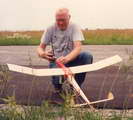
My friend and mentor, Roger Schroeder, left us in September. Roger suffered a heart attack and although bypass surgery went well, he passed away on Wednesday, 16 September, 2009. While it goes without saying that I for one will miss him, he has left behind so many good memories and smiles that I'd prefer to be happy I got to know him, rather than sad he is no longer an email away. Roger contributed a lot of ideas and content to this web site which is peppered with his wisdom, so the remembering will be easy.
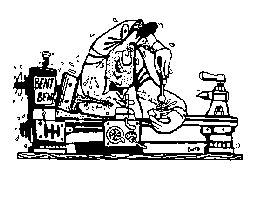
Roger was born in 1930 and began modelling in 1938. His first engine powered model was a Playboy Sr with a borrowed Super Cyclone. His first engine was a Brownie 29 and he retained a special fondness for that model all his life. Like many of us, his engine collection came about more by accident than design. If pressed for a date for the start, it would be 1962 which places him at the front of the wave as the next year, 1963, saw the appearance of The Engine Collectors' Journal (yes, there were four issues of something similar in '62, but let's go with '63 and Volume 2 as the start). Shortly after, an item called Engine-uity by Schroeder began appearing as an occasional column where Roger wrote tips for the more mechanically minded collectors. In Volume 5, Issue 2 (Nov/Dec 1966), Engin-uity started a series for engine builders: the Schroeder Twin. This was a horizontally opposed twin based on Cox 020 cylinders. Roger wanted builders to succeed and made seven prototypes before commencing the series which was a hit with ECJ readers, so others followed and Roger's column became a fixture in ECJ all the way to the present day.
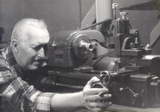
Following his barstock designs, Roger added aluminium casting to his basement workshop and began supplying castings and plan kits to model engine builders under the name Classic Model Airplane Engine Construction Kits. All his engines were prototyped and refined for builders at the low end of the experience and skill range and his after-sales service was outstanding. My first Classic kit was the Original Ohlsson and the page dedicated to this engine tells how Roger quietly made sure I became a happy customer and a convert to model engine making. When Bob Washburn launched Strictly IC in 1988, Roger was one of the Contributing Editors. His Winged Motors series followed his philosophy of simple engines that could be built by those with modest equipment, low skills, and bit of determination. His last design to appear in SIC was another Cox based opposed twin—this time using 049 cylinders and it was my privilege to collaborate with him on this project and get to see my name alongside his on the credits line. I always felt that this was a bit undeserved on my part as he did all the work; all I did was build a second prototype and proof-read his text, but I sure got a kick out of it, which I rather suspect was just what he intended.
Roger was also one of the original Motor Boys and recognized the use this website would be to new model engine builders. So in 2002, he began to gently prod me until I saw the light and reorganized the sprawling mess to the somewhat more structured and orderly maze of twisty little passages you see today. We miss him, but are glad to have known him.
Classic Casting Kits

Roger's family has asked me, as webmaster for the Classic Model Airplane Construction Kits website, to tell everyone what should now be painfully obvious: you can no longer place orders for the kits. We all regret this as these simple and inexpensive kits have brought enjoyment to many budding and experienced model engine builders over the past thirty odd years. But the patterns and drawings have been preserved and the Schroeder family would like to see the line continued by someone of suitable skill, enthusiasm, and nature. The patterns are now under the care of Motor Boy and ECJ editor, Tim Dannels. Contact him if you are serious about continuing Roger's legacy. In the mean time, I've setup a redirect so any bookmarks to the Classic web site come to these entries. Roger's treatise titled Building a Model Airplane Engine That Runs remains on-line, with contact details elided.
Glow Chief 49 Repro
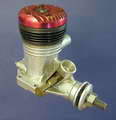
David Burke of Adelaide Automotive PL has a deep affection for the Taipan, Glow Chief, and Sabre range of engines made by Gordon Burford, also of Adelaide, South Australia. DB also has the original old dies for many of the engines and is planning a reproduction run of the Glow Chief 49, an example of which is pictured here. The engine is a bit unusual in relation to the placement of the exhaust on the opposite side from where we might expect it to be. So when mounted inverted in a control-line stunter, the exhaust would be on the outside of the circle and as a result, the gunge would tend to be thrown away from the model rather than all over it, as we prefer. Not only that, the needle would be on the opposite side to the exhaust, making it difficult to roast your pinkies while trying to adjust the needle. Obviously such a ludicrous arrangement did not catch on and later engines were more sensible. Anyway, DB is in the data gathering phase of the project and would welcome contact with owners of surviving examples of this engine. You can contact him through Model Engine News.
Update on NOS Olivers
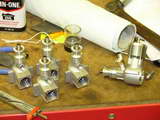
Back in the February Issue, we mentioned the effort being undertaken by Tom Ridley to build new Oliver Tigers and Oliver Cubs to the old, original specification—what guitar collectors call "New Old Stock" (NOS), meaning they are new, but are the same as an original that has sat in the case under a bed for the past fifty years. Tom's Olivers will be just like that, which makes them eligible for vintage use. Even better, it means that there is now a source of spares for the old originals! Gordon Cornell, whose highly detailed series on Model Engine Development is available on this web site, has been visiting Tom's shop at Hinckley near Coventry and this month he provides some photos and observations on progress to date; be sure to visit the Oliver Production page and get your check book out.
Twin-carb Development
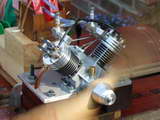
Mention of the Model Engine Development allows us segue neatly into this piece of news from John Beddard (UK). We have seen this engine before in The Gallery, but not at this level of development. John set about building a Chenery V-Twin with Vega-style heads—that's the Dave Parker designed Vega V-Twin from Model Engineer issue 3768, not the John Harbone designed series of the same name. Building a model engine is an accomplishment. Building a twin cylinder four-stroke raises the bar significantly. Many, myself included, tend to be happy to complete a project and watch it run, but there are others who are not content until they have analysed performance, postulated how improvement might be obtained, then carried through, sometimes moving forward, sometimes backward. John has now debugged a twin-carb modification to his V-twin and reports vastly improved performance over the single carb and T-piece setup. John says thanks go this his friend Graham Meek—whose Cam Making Made Easy page appears in the How To pages—for his CAD work and telephone help on the modifications.
Auction Puzzle
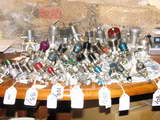
Remember Ron Moulton's prelude to the Prof Doug Walton auction? 840 engines in 232 lots? Our own Eric Offen attended and came away with eleven lots comprising some 32 engines. Eric felt that prices were down on what has been seen before—perhaps an indication that the global crash has even penetrated our tiny part of the economy. For example, Lot 80 comprising eight English engines including a 0.8cc EPC Moth and a 0.5cc ACE went for £420. All lots were plus buyers premium of 20.2% including tax and to add insult to injury, most of the engines were new, like new, or at the worst, very good condition. The photo shows Eric's spoils. See how many you can identify!
Auction Jem
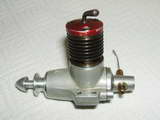
One bidder at the Walton auction came away with more than he knew at the time. The engine had appeared in the auction catalogue as a Dysene (sic) .9 diesel and lacking any idea what this might be, the new owner sent pictures to us here at MEN for identification. That was an easy one; the engine being quite familiar through knowledge of Gordon Cornell's work, namely a somewhat used example of the short-lived Dynamic 049 diesel from the 1961. A very short page on the engine has been created and included in The Engine Finder. We may be able to get Gordon to expand on this sometime in the future.
New Books and Magazines This Month

Apart from a few model engineering magazines, no graft—err, new books were received this past month. But one thing I should mention and should have mentioned some time back, is an article by Charlie Stone that appeared in Issue 4345, page 204 of the Model Engineer on home-made glow plugs. Charlie (the self-proclaimed Pest from the West  ) describes the process he devised for making his own glow plugs using nothing very special, and the success achieved, eventually. Before you ask "why?" consider the trouble Eric Whittle went through modifying commercial glow-plugs for his 1/9th scale Cirrus and Aero V-8 engines. The ability to produce perfectly serviceable glow-plugs in threads smaller than 1/4-32 is a trick all advanced model IC engine builders should have up their sleeve. Another series of articles on the subject appeared in SIC way back, including a cunning spot-welder for the platinum element; yet more tricks for the bulging sleeve...
) describes the process he devised for making his own glow plugs using nothing very special, and the success achieved, eventually. Before you ask "why?" consider the trouble Eric Whittle went through modifying commercial glow-plugs for his 1/9th scale Cirrus and Aero V-8 engines. The ability to produce perfectly serviceable glow-plugs in threads smaller than 1/4-32 is a trick all advanced model IC engine builders should have up their sleeve. Another series of articles on the subject appeared in SIC way back, including a cunning spot-welder for the platinum element; yet more tricks for the bulging sleeve...
Engine Of The Month: Hope 19 Range
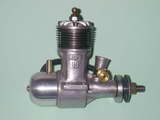
We continue the in-depth investigation into the obscure Japanese Hope range of model engines this month. The amount of information that Adrian Duncan and Alan Strutt have been able to uncover on this manqué is truly astonishing to me. The pages, chapters, whatever, are linked together with "Next" and "Previous" links at the foot of the text so you can dance back and forth as required.
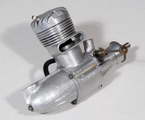
Software engineers know that no piece of software is ever complete, but at some point in time it does become releasable. Seems that Adrian's earlier piece on the enegmatic Sky Shark falls into this category. And just like software, when a fix is required, you have a couple of options: apply a patch, or rewrite it and issue a new version. A fix is good when the changes required are small, but at some point, you face the danger that due to the number of patches required, the probability of screwing something else up becomes too great and the dreaded rewrite is necessary. That's the decision we came to in regard to the earlier Sky Shark page. There are things here and there that are common to the 1.0 page, but consider the new page you can get to via the previous link, or the thumbnail picture, to be a 2.0 release that is bigger, and more accurate.
Boll-Aero 18
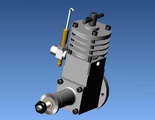
Last month I promised readers a free plan set for Chris Boll's cleverly named Boll-Aero 18, a 1.8cc barstock engine based on the ML Midge side-port diesel. For various reasons, time ran out with the set not quite finished, but a promise is a promise, is a promise—to Chris and to y'all, so you get an almost complete plan preview this month and the completed set next month. The PDF plan set for the Boll-Aero 18 sits at eight sheets right now, with more to come that show the required laps and hone.
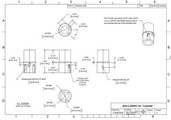
The Boll-Aero 18 Plan Set is essentially complete, but they have not been as thoroughly checked as I'd like. However I believe they will suffice for the adventurous to start mutilating metal. In preparing the CAD set, I've redrawn Chris' propdriver design to use the split cone collet the Motor Boys favor, but I also want to present Chris' original design which has the benefit of simplicity at the expense of a distinct possibility of throwing a prop. By presenting both, the builder can decide what is within their skill range and comfort zone  ! If I get carried away, a Burford-like "splined" prop driver sheet might get done as well. Other minor changes are a jam-nut for the venturi and a reduction in the size of the transfer passages to allow the engine bore to be increased by experimenters. The original engine plan used British Association (BA) threads. Knowing these are a problem in certain parts of the world, I've shown UNC/UNF equivalents, as well as possible metric alternates. The design was dimensioned in Imperial measurements, but for thoroughly modern model engineers, the plan set carries dual Imperial and Metric measurements. A big thanks goes to Chris for his generosity. Show how much you appreciate this by sending us photos of your Boll-Aero progress for all to enjoy.
! If I get carried away, a Burford-like "splined" prop driver sheet might get done as well. Other minor changes are a jam-nut for the venturi and a reduction in the size of the transfer passages to allow the engine bore to be increased by experimenters. The original engine plan used British Association (BA) threads. Knowing these are a problem in certain parts of the world, I've shown UNC/UNF equivalents, as well as possible metric alternates. The design was dimensioned in Imperial measurements, but for thoroughly modern model engineers, the plan set carries dual Imperial and Metric measurements. A big thanks goes to Chris for his generosity. Show how much you appreciate this by sending us photos of your Boll-Aero progress for all to enjoy.
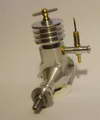
The engine pictured here is Rob Jenkin's progress on the design from the Aviation Modeller plans. Rob wanted more of a "Midge" look to his engine, so machined the crankcase as a single piece rather than as drawn with a separate nose-piece. He has also inserted a bronze bush and fitted the prop driver using a split collet, but apart from that—and a neat ETA treatment to the brass compression screw—it's standard. When the photo was taken, Rob still had holes to tap, a job we all love and look forward to with relish, so his engine has yet to run.
Tech Tip of the Month
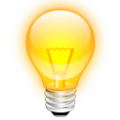
Just about every month I wonder what the devil I'm going to offer up as a Tech Tip, and just about every month a last minute email arrives from someone asking a question that triggers the proverbial light-bulb like Ah-ha! moment and the Tech Trip emerges. This month the email came from Kirk Burwell of Hemingway Kits. As the Hemingway range of IC engine kits has been increasing, Kirk wrote asking if there was any particular wire suited to spark-plug leads for models. Yes, there is, and also, Ah-ha! Tech Tip!!
The ideal wire for our models would be like the full size counterpart: low resistance and flexible, with strong insulation, able to survive in a very hot, oily environment while being subjected to unusual levels vibration. Normal hookup wire will do the job, but it is not all that flexible and the insulation melts rather easily. Worse, it can become brittle with extended exposure to heat, oil, and ultra-violet radiation (sunlight). The specification for "standard" hook-up wire—if there is any such thing—was "14-0076" meaning it contained fourteen strands of tinned copper wire, each with a diameter of about 0.008". There are heavier and lighter gauges, usually having more or less strands of the same wire, but the plastic insulation on all is about the same. However there is another significantly different class of multi-strand, insulated wire which was designed for use as test-leads for electronic and laboratory equipment that suits our needs much better.
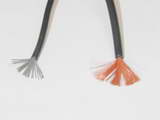
Like your basic barnacle, once "hook-up" wire is in place, it is not expected to ever have to move again. Test-leads on the other hand will spend their entire life being bent, tugged, pulled, tied in knots, while quite possibly being exposed to some rather unhospitable conditions. Accordingly, they are made with lots and lots of very, very fine strands about 0.001" in diameter. This makes the lead very flexible, with extremely low electrical resistance. The insulation is both thicker and made of a totally different compound able to rest against a hot soldering iron for some time with no more than cosmetic damage. Today, this insulation is generally silicon based and so will be unaffected by exposure to a variety of oils and solvents, hot or otherwise. As a bonus, the thicker insulation gives a more scale-like appearance when used on our usual 1/4" spark plugs. Naturally, there is an extra cost involved, but it is not awful and you can buy it by the meter at any reasonably stocked electronics warehouse in black and red at the very least. Kirk says he will look into stocking it too.
 Roger J Schroeder
Roger J Schroeder
 Classic Casting Kits
Classic Casting Kits
 Glow Chief 49 Repro
Glow Chief 49 Repro
 Update on NOS Olivers
Update on NOS Olivers
 Twin-carb Development
Twin-carb Development
 Auction Puzzle
Auction Puzzle
 Auction Jem
Auction Jem
 Boll-Aero 18
Boll-Aero 18
 Editorial
Editorial
 New Books and Magazines This Month
New Books and Magazines This Month
 Engine Of The Month: Hope 19 Range
Engine Of The Month: Hope 19 Range
 Tech Tip of the Month
Tech Tip of the Month
 Standard Stuff
Standard Stuff











 ) describes the process he devised for making his own glow plugs using nothing very special, and the success achieved, eventually. Before you ask "why?" consider the trouble Eric Whittle went through modifying commercial glow-plugs for his 1/9th scale Cirrus and Aero V-8 engines. The ability to produce perfectly serviceable glow-plugs in threads smaller than 1/4-32 is a trick all advanced model IC engine builders should have up their sleeve. Another series of articles on the subject appeared in SIC way back, including a cunning spot-welder for the platinum element; yet more tricks for the bulging sleeve...
) describes the process he devised for making his own glow plugs using nothing very special, and the success achieved, eventually. Before you ask "why?" consider the trouble Eric Whittle went through modifying commercial glow-plugs for his 1/9th scale Cirrus and Aero V-8 engines. The ability to produce perfectly serviceable glow-plugs in threads smaller than 1/4-32 is a trick all advanced model IC engine builders should have up their sleeve. Another series of articles on the subject appeared in SIC way back, including a cunning spot-welder for the platinum element; yet more tricks for the bulging sleeve...






